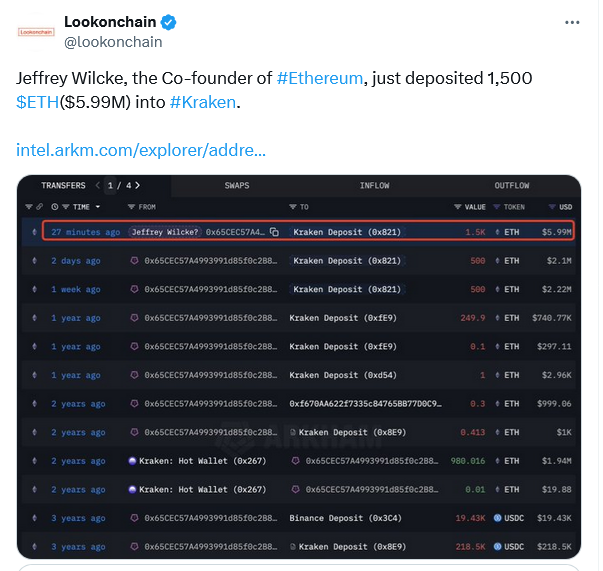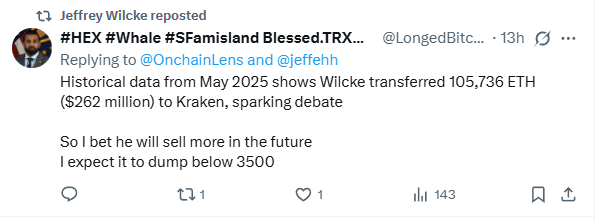Jeffrey Wilcke ETH transfer: Ethereum co-founder Jeffrey Wilcke moved 1,500 ETH (~$6 million) to Kraken on Thursday. The onchain move, reported by Lookonchain as a Kraken deposit, may indicate sales intent but does not confirm a sell — deposit-to-exchange transfers often precede withdrawals or internal rebalancing.
-
1,500 ETH moved to Kraken
-
Transaction noted by onchain analytics platform Lookonchain; transfer coincided with a minor ETH price drop.
-
At least 15 whales bought ~406,000 ETH (~$1.6B) in the same period, signaling accumulation by large holders.
Jeffrey Wilcke ETH transfer: Read detailed transaction context, whale buying data, and market implications. Stay informed with COINOTAG coverage.
Ethereum co-founder Jeffrey Wilcke seemingly still holds hundreds of millions worth of Ether across multiple wallets.
Published: 2025-09-26 Updated: 2025-09-26 Author/Organization: COINOTAG
Ethereum co-founder Jeffrey Wilcke could be preparing to move or rebalance holdings after sending around 1,500 ETH to crypto exchange Kraken on Thursday. The transaction was recorded as a Kraken deposit by onchain analytics platform Lookonchain. Moving funds to an exchange does not guarantee a sale but raises market-watch flags.

Source: Lookonchain
What happened in the Jeffrey Wilcke ETH transfer?
The Jeffrey Wilcke ETH transfer was a deposit of 1,500 ETH (approximately $6 million) to Kraken, detected by Lookonchain. The deposit coincided with a dip in Ether’s price from $4,000 to roughly $3,900. Deposit does not equal sale; onchain behavior can represent custody moves, exchanges between personal wallets, or preparatory steps for sale.
How large were Wilcke’s recent movements and past deposits?
In August, Wilcke deposited $9.22 million worth of ETH to Kraken, and historically he moved as much as $262 million worth of ETH to Kraken then redistributed to new wallets, according to onchain observers. Public commentary and reposts by Wilcke on X have fueled speculation that more transfers or sales could follow. These details come from public onchain analytics reporting and social activity; they are reported here as factual onchain events without speculative claims.
Moving funds to an exchange address is a common step before selling, but it can also reflect wallet consolidation or transfers between custodial accounts.

Source: Jeffrey Wilcke
How are Ether whales reacting during this period?
Despite a recent 13% seven-day decline in ETH, significant whale accumulation has been recorded. At least 15 wallets bought more than 406,000 ETH (about $1.6 billion) over two days, per onchain analytics. Major liquidity venues involved in those buys included Kraken, Galaxy Digital, BitGo, and FalconX — all referenced as custodial or exchange counterparties in onchain transaction logs.
What does big-wallet buying mean for price action?
Heavy accumulation by whales can create upward pressure over time if holdings move off-exchange into cold storage. Conversely, concentrated deposits to exchanges, like Wilcke’s, introduce potential sell-side risk. Market impact depends on whether exchange deposits are sold or internally rebalanced.
Frequently Asked Questions
Will Wilcke’s deposit cause a price drop?
Exchange deposits can increase sell-side pressure if executed, but a single 1,500 ETH deposit is unlikely to move the market significantly compared with aggregated whale trades and macro liquidity. Short-term volatility is possible if large sell orders hit order books.
How do onchain analytics identify these transfers?
Onchain analytics platforms track wallet addresses, exchange deposit addresses, and transaction flows. Platforms named in public reporting include Lookonchain and other onchain trackers; these services infer deposit intent based on known exchange address mappings and transaction patterns.
Key Takeaways
- Wilcke moved 1,500 ETH: A Kraken deposit recorded by onchain analytics; not proof of sale.
- Whales are buying: At least 15 wallets bought ~406,000 ETH (~$1.6B) in two days, showing accumulation.
- Market impact depends on execution: Exchange deposits create potential sell pressure; actual impact requires execution data.
Conclusion
Jeffrey Wilcke’s recent 1,500 ETH transfer to Kraken is a verifiable onchain event that warrants monitoring but does not confirm a sale. Combined with large-scale whale accumulation, the net effect on Ether’s price will depend on subsequent exchange activity and broader market dynamics. COINOTAG will continue to track onchain flows and market responses.





